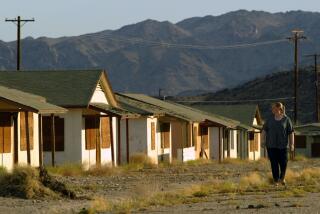Timber Sales in Happy Camp
- Share via
“Timber Town’s Decline Rivals That of Spotted Owl” (Oct. 23) reminds me of my assignment to Happy Camp in 1949. In those days, a timber sale was limited to $500 by the district ranger, but it was not long before the demand for timber greatly exceeded that restriction, new mills appeared in Happy Camp and the highway connecting those mills to Yreka was under improvement; all of this activity was created by the need for housing for the returning servicemen. My specific assignment was to develop the road system in the woods to get the logs to the mills.
Even in those more hectic times, it was obvious to me that the sustained yield law was constantly overlooked, leading to larger and larger timber sales that rapidly depleted the stands of old growth trees. So, much like the early-day miners who were after gold, it was inevitable that sooner or later the supply of timber would leave a rapidly growing town in its current predicament. In 1949, the total population of Happy Camp was approximately 300 souls. But, for Jim Waddell to suggest that “if the government would just step aside” is sheer folly, for those few trees that remain would be gone in a matter of several years. Then, the mills would be gone, recreation as we know it would be gone, as well as the clear streams and fishing so urgently needed to sustain a reasonably sized town from recreation revenues. Unfortunately, few people recognize that bigger is not necessarily better, and that the resources are more or less finite, much like the gold that created a larger town at Happy Camp than I knew in 1949. What took nature hundreds of years to develop, man more or less destroyed in less than half a century.
JAMES R. PRATLEY
U.S. Forest Service (retired)
San Diego
*
* The “rugged individualists” on welfare in Happy Camp need to stop whining and go out and get a life. The loggers may think they are exempt, but they are in the same boat as all the rest of us whose jobs are vanishing because of “re-engineering.” The slogan for the new world economy is adapt or die, and the sooner they understand that the better off they’ll be.
IAN HALSEMA
Los Angeles
*
* Richard Paddock’s article did a very good job of explaining the hardship to people caused by well-meaning but overzealous environmentalists. There were two items in the article that I felt were misleading. The first deals with the spotted owl. Although the owl can survive in “undisturbed” forests, it does much better in timber stands where logging has occurred. Logged forests generally allow greater sunlight to reach the forest floor, thus promoting the growth of brush and grasses which are the primary food for rodents, which in turn are the primary food for the owl.
The second item deals with timber available for harvest. The article talks about the fact that Forest Service officials were “forced to reduce” the annual harvest to 8 million board feet per year. This statement implied that this forced reduction resulted from a lack of timber for harvest. In reality, the forced reduction was caused by bureaucratic administrative decisions designed to avoid lawsuits from “big-city environmentalists.” The 8-million- board-foot harvest does not even come close to harvesting the annual mortality in the forest. The annual growth in the Happy Camp district is probably close to 50 million board feet per year.
H. JAMES HOLMES
Brownsville, Calif.
More to Read
Sign up for The Wild
We’ll help you find the best places to hike, bike and run, as well as the perfect silent spots for meditation and yoga.
You may occasionally receive promotional content from the Los Angeles Times.






